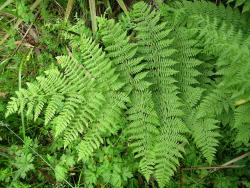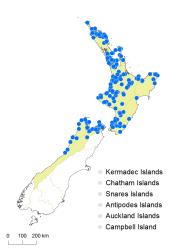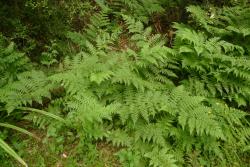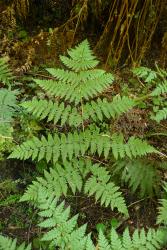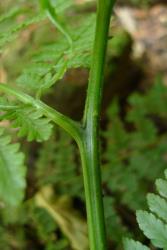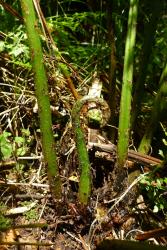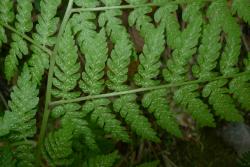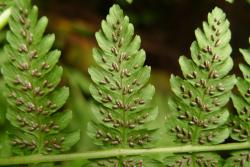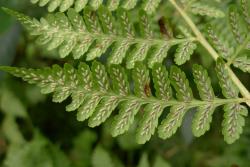- ≡ Allantodia australis R.Br., Prodr. Fl. Nov. Holland. 149 (1810)
- ≡ Athyrium australe (R.Br.) C.Presl, Tent. Pterid. 98 (1836)
- ≡ Asplenium brownii J.Sm., J. Bot. (Hooker) 4: 174 (1841) nom. nov. pro Allantodia australis R.Br. 1810
- ≡ Asplenium australe (R.Br.) Brack., U.S. Expl. Exped., Filic. 16, 173 (1854) nom. illeg., non Asplenium australe Sw. 1801
- ≡ Athyrium brownii (J.Sm.) J.Sm., Hist. Fil. 328 (1875) nom. illeg.
- ≡ Athyrium umbrosum subsp. australe (R.Br.) C.Chr., Index Filic. 36, 147 (1905)
- ≡ Athyrium umbrosum var. australe (R.Br.) Domin, Biblioth. Bot. 20(85): 86 (1913)
- = Allantodia tenera R.Br., Prodr. Fl. Nov. Holland. 149 (1810)
Rhizomes erect, sometimes forming short woody trunks or occasionally prostrate; bearing scales. Rhizome scales narrowly ovate, up to 6 mm long and 1 mm wide, dark brown. Fronds 340–1400 mm long. Stipes 80–800 mm long, blackish-brown proximally, yellow-brown or red-brown distally; bearing narrowly ovate dark brown scales, up to 15 mm long and 2 mm wide. Rachises yellow-brown or red-brown, winged only at distal end, adaxially grooved, glabrous or with a few scattered scales in developing fronds. Laminae 2-pinnate-pinnatifid to 3-pinnate-pinnatifid, ovate to broadly ovate, tapering rapidly to a pinnatifid apex, 170–780 mm long, 110–740 mm wide, dark green on both surfaces, herbaceous, glabrous. Primary pinnae in 9–18 pairs, widely spaced to overlapping, winged at distal end or rarely winged throughout in small fronds, ovate or narrowly ovate; the longest at or near the base, 80–525 mm long, 40–270 mm wide, apices acute to acuminate, bases stalked. Secondary pinnae winged throughout, gradually decreasing in length along each primary pinna to its apex; the longest secondary pinnae narrowly ovate, 20–165 mm long, 10–70 mm wide, apices acute, margins divided nearly to the midrib in smaller fronds or divided into tertiary pinnae in largest fronds, bases short-stalked; the distal secondary pinnae narrowly ovate to oblong, apices acute, bases adnate. Longest tertiary pinnae or pinna segments oblong, 5–38 mm long, 2–12 mm wide, apices acute or obtuse, margins serrate to divided almost to the midrib, bases adnate or short-stalked. Quaternary pinna segments up to 7 mm long and 3 mm wide. Veins free. Sori linear, elongated along one or both sides of veins; indusia 1–2 mm long, opening away from vein, free margins entire or lightly toothed.
Note: measurements given above are from measurable herbarium specimens. Larger fronds are known to occur in the wild. AK 157334 comprises parts of a frond that was said to be 2 m long. Laminae may reach 1200 mm long and 900 mm wide.
Diplazium australe is recognised by its erect rhizomes that sometimes form a short trunk, and fronds that are more or less 3-pinnate and are either glabrous or bear a few scales on the stipes and rachises. The sori are elongated along the veins, either singly or with at least a few arranged back-to-back. The free margins of the indusia are entire or only lightly toothed.
North Island: Northland, Auckland, Volcanic Plateau, Gisborne, Taranaki, Southern North Island.
South Island: Western Nelson, Sounds-Nelson, Westland.
Altitudinal range: 0–800 m.
Diplazium australe occurs in lowland areas throughout much of the North Island from Te Paki to Wellington, but is absent from large parts of the east coast. It is most commonly found below 350 m but extends to 500 m in Taranaki and on Rainbow Mountain, near Rotorua, and 800 m on Mt Pirongia. In the South Island it is confined to lowland areas of the Marlborough Sounds, Nelson, and the West Coast as far south as Hokitika. It does not occur on any of the offshore islands.
Also Australia (Queensland, New South Wales, Victoria, Tasmania) and Norfolk Island.
Diplazium australe is a terrestrial fern that grows in damp soils and silt along stream banks, on alluvial terraces and swamp margins, in damp paddocks and ditches, and on forest margins and in clearings. It grows under podocarp (especially kahikatea) and broadleaved forest, under mature mānuka and kānuka, and under Pinus and willows. It is often found in association with Deparia petersenii.
n = 123 (Brownlie 1958).
The names Asplenium umbrosum Sm. and Athyrium umbrosum (Aiton) C.Presl used in earlier New Zealand Floras are misidentifications of Diplazium australe.



